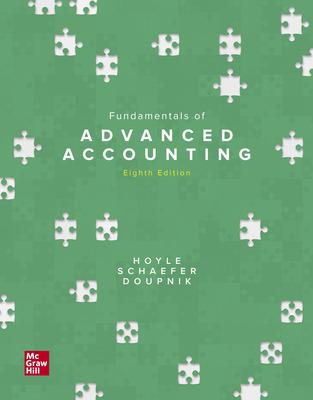Question
I need assistance with the following homework questions: The Heath Corporation reported net income for 2015 of $177,500. Heath began the year with 100,000 shares
I need assistance with the following homework questions:
- The Heath Corporation reported net income for 2015 of $177,500. Heath began the year with 100,000 shares of $5 par
value common shares outstanding and 2,500 shares of $100 par value 8% preferred shares outstanding. On October 1, Heath sold 10,000 shares of common stock for $6 per share. Heath paid dividends to the common shareholders in December.
The basic earnings for 2015 is:
- A.$1.43 per share.
- B.$1.50 per share.
- C.$1.54 per share.
- D.$1.73 per share.
2. Susqua, Inc. has held-to-maturity debt securities it purchased in 2014. At December 31, 2015, Susqua, Inc. reported a $120,000 impairment loss related to these securities. During 2016, the debtor was successful in registering a new patent which improved the debtors operating outlook. This change of events resulted in a reversal of $45,000 of the impairment loss. At December 31, 2016, the fair value of the debt securities had increased by $68,000 over the impaired value previously recorded. Susqua, Inc. uses IFRS for its external reporting. How much, if any, of this reversal can Susqua, Inc. report in its income for 2016?
- A.$ - 0 -
- B.$120,000
- C.$68,000
- D.$45,000
3. When an investor is capable of influencing the investee companys dividend policy, the investor is able to augment its own reported income when using:
- A.minority passive accounting treatment.
- B.minority active accounting treatment.
- C.majority active accounting treatment.
- D.the equity method.
4. The difference between the amortized cost basis of a debt security and the present value of expected cash flows for that security discounted at the effective interest rate implicit in the debt instrument when it was originally acquired is called the:
A.amount representing the credit loss.
- B.amount related to all other factors.
- C.other-than-temporary impairment.
- D.subsequent recovery in fair value
Step by Step Solution
There are 3 Steps involved in it
Step: 1

Get Instant Access to Expert-Tailored Solutions
See step-by-step solutions with expert insights and AI powered tools for academic success
Step: 2

Step: 3

Ace Your Homework with AI
Get the answers you need in no time with our AI-driven, step-by-step assistance
Get Started


